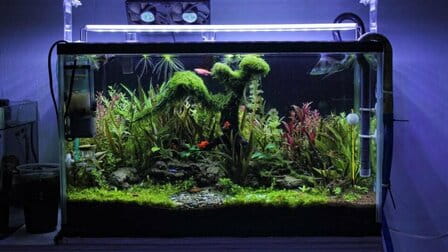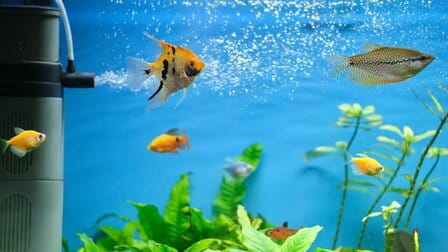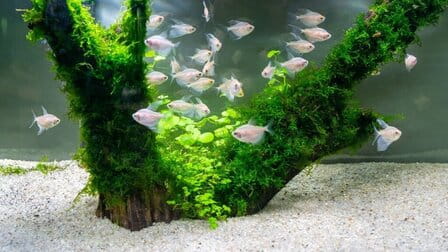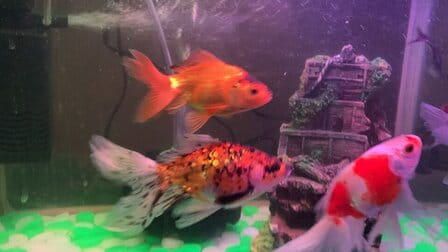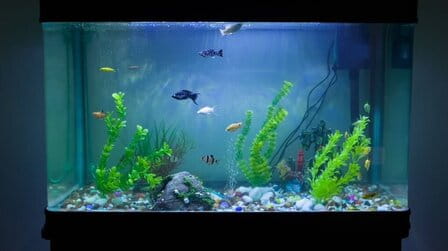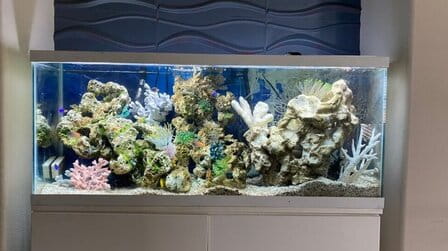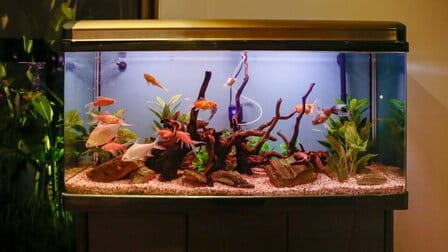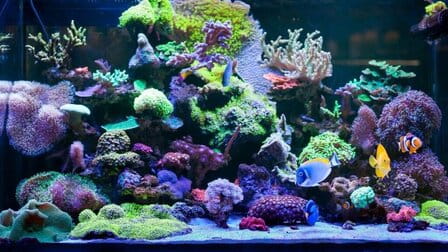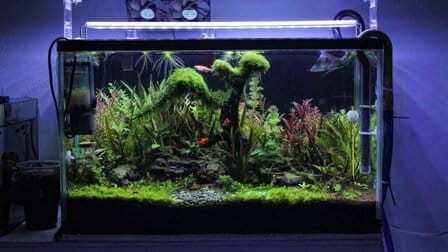Imagine stepping into a tranquil underwater world, where vibrant colors sway with the gentle currents and aquatic life thrives in harmony. This idyllic scene is not limited to the depths of the ocean; it can be recreated right within your own living space through the magic of aquarium plants. These lush and vibrant greens not only add visual appeal to your aquarium but also contribute to the well-being of its aquatic inhabitants. Join me as we embark on a comprehensive journey to learn the ins and outs of different types of aquarium plants, uncovering the beauty, benefits, and secrets they hold for your aquatic oasis.

Different Types Of Aquarium Plants
1. Foreground Plants: Adding Depth and Texture
Foreground plants are the foundation of your underwater landscape, creating a seamless transition from the substrate to the middle and background areas. These plants are usually smaller in size and are positioned at the front of the aquarium to enhance depth and visual interest. Their delicate and intricate features draw the viewer's gaze, inviting them to explore the captivating world within the tank.
Dwarf Hairgrass (Eleocharis parvula): With its slender blades that resemble a lush green carpet, dwarf hairgrass is a favorite choice for foreground planting. It creates a stunning illusion of a grassy meadow beneath the water's surface, offering a picturesque setting for your aquatic inhabitants to roam.
Java Moss (Taxiphyllum barbieri): This versatile moss is a staple in aquariums, as its delicate fronds create a soft, inviting texture. Attach it to driftwood or rocks to create natural hiding spots for fish and shrimp, fostering a sense of security.
Cryptocoryne spp.: Crypts come in various species, each contributing its unique charm to your aquascape. Their broad leaves and rich colors add a touch of elegance, and their adaptability to different light conditions makes them a great choice for both beginners and experienced aquarists.
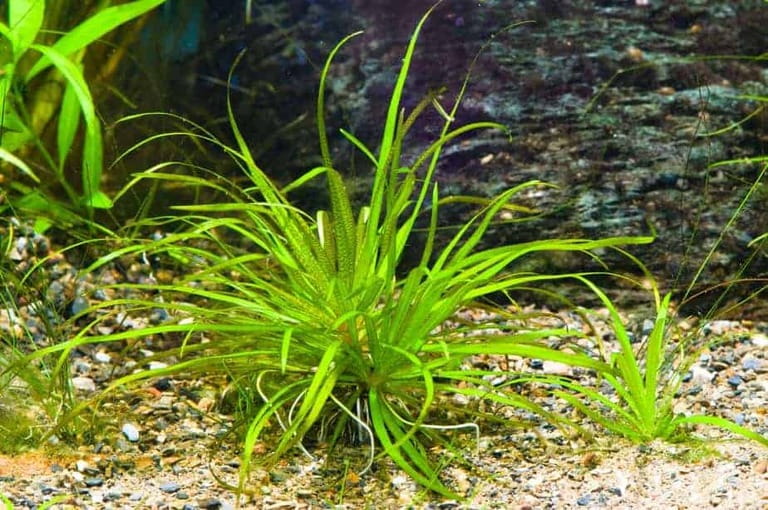
2. Midground Plants: Striking a Balance
Midground plants serve as a bridge between the foreground and background elements of your aquarium. They introduce a dynamic visual layer that enhances the overall aesthetics of the tank. These plants are often taller and add verticality to your underwater world, creating a sense of depth that draws the observer into the scene.
Anubias spp.: Anubias plants boast robust and broad leaves that add a touch of boldness to your aquascape. They're a favorite among aquarists for their ease of care and ability to thrive in low-light conditions. Attach them to driftwood or rocks to create stunning focal points.
Amazon Sword (Echinodorus spp.): Named for its striking sword-like leaves, the Amazon Sword plant creates an eye-catching centerpiece. Its lush foliage adds a touch of elegance to your tank, and its vibrant green hues create a refreshing contrast against the aquatic blue.
Java Fern (Microsorum pteropus): Java ferns are known for their unique leaf structure, which resembles delicate lace. They can be attached to decorations or substrate, creating a captivating display that adds an element of mystique to your aquatic realm.

3. Background Plants: Adding Drama and Depth
Background plants are the backbone of your aquatic haven, creating a lush backdrop that adds depth and dimension to the tank. Their taller stems and foliage extend toward the water's surface, forming a verdant canvas that sets the stage for your aquatic inhabitants to thrive and flourish.
Hornwort (Ceratophyllum demersum): Hornwort is a fast-growing plant that offers excellent cover for fry (baby fish) and provides a naturalistic touch to your tank. Its feathery appearance adds a delicate beauty that sways with the water's movement.
Dwarf Sagittaria (Sagittaria subulata): Dwarf sagittaria is a grass-like plant that forms dense clusters, creating a vibrant green background. Its slender leaves add a touch of elegance, and its ability to propagate easily makes it a favorite among aquascapers.
Giant Hygrophila (Hygrophila corymbosa): With its impressive height and lush leaves, giant hygrophila adds a dramatic touch to larger aquariums. It serves as an excellent focal point while contributing to the overall aesthetics of your aquatic landscape.

4. Floating Plants: Adding Beauty and Function
Floating plants introduce a unique dimension to your aquarium by resting at the water's surface. They create shaded areas, provide natural filtration, and serve as a refuge for fish and fry. These plants are excellent tools for maintaining water quality and promoting a balanced ecosystem.
Duckweed (Lemna minor): Often hailed as the world's smallest flowering plant, duckweed forms a carpet-like layer on the water's surface. It provides shade, helps control algae by absorbing excess nutrients, and adds a touch of whimsy to your tank.
Water Lettuce (Pistia stratiotes): With its rosette-like structure and vibrant green color, water lettuce adds an elegant touch to your aquarium. It creates shaded areas and provides a safe haven for fish seeking refuge.
Salvinia spp.: Floating ferns of the Salvinia genus feature distinctive leaves that help create shaded areas in the aquarium. These shaded spots reduce light penetration, helping to prevent algae growth while offering an appealing aesthetic.

5. Aquascaping Tips for Success
Creating a thriving planted aquarium requires more than just selecting the right types of plants. Consider these tips to ensure your aquatic plants flourish and contribute to a vibrant ecosystem:
Lighting: Different plants have varying lighting requirements. Research the lighting needs of your chosen plants and provide the appropriate intensity and duration. Investing in high-quality aquarium lighting will pay off in the long run.
Substrate: Use a nutrient-rich substrate to provide essential minerals and nutrients to the plants' roots. Substrate options range from specialized plant substrates to nutrient-rich gravel.
Fertilization: Depending on the plants and setup, you may need to supplement with liquid or root fertilizers to ensure optimal growth. Regular fertilization ensures that your plants have access to the essential nutrients they need to thrive.
CO2 Injection: In high-tech setups, adding carbon dioxide (CO2) can significantly enhance plant growth. CO2 supplementation is particularly beneficial for demanding plants that require more carbon for photosynthesis.
Maintenance: Regular pruning and maintenance are essential to prevent overgrowth, ensure proper circulation, and maintain water quality. Trim dead or yellowing leaves to keep your aquarium looking pristine.

Conclusion
As we've journeyed through the lush world of different types of aquarium plants, it's evident that these greens bring much more than mere aesthetic charm to your underwater realm. From providing shelter and perches for aquatic inhabitants to contributing to water quality and aesthetics, aquarium plants play a vital role in creating a balanced and captivating aquatic ecosystem.
Whether you're a seasoned aquarist or a beginner looking to embark on a journey into the world of aquatic gardening, the diversity of aquarium plants offers something for everyone. As you curate your aquatic masterpiece, consider the unique qualities and benefits each type of plant brings to the table. By weaving together the vibrant tapestry of foreground, midground, background, and floating plants, you'll craft an underwater paradise that showcases the splendor of aquatic life in all its forms. In the heart of your aquarium, a verdant symphony of colors, textures, and life will flourish, transforming your tank into a breathtaking aquatic oasis that mesmerizes both you and your aquatic inhabitants alike.

